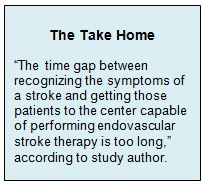Key Points:
- Study examines change in ASPECTS score during interhospital transfer of ischemic stroke patients
- ASPECTS decays enough for 31% to lose eligibility for intra-arterial therapy
Rapid deterioration of ischemic stroke patients, as measured by Alberta Stroke Program Early CT Score (ASPECTS), during interhospital transfer means that nearly one-third lose eligibility for intra-arterial stroke therapy en route. The study authors view these findings, which are published online April 22, 2016, ahead of print in the Journal of NeuroInterventional Surgery, as a call to speed up transit of eligible stroke patients to comprehensive stroke centers.
Maxim Mokin, MD, PhD, of the University of South Florida (Tampa, FL), and colleagues sought to analyze factors associated with changes in ASPECTS during interhospital transfer and their potential impact on eligibility for intra-arterial stroke therapies in patients with anterior circulation ischemic strokes. To do so, they reviewed cases that were transferred to their comprehensive stroke center from outside facilities between January 2012 and December 2014.
Stroke evolution toward an unfavorable ASPECTS score (< 6) upon arrival occurred in 13/42 (31%) patients who initially had a favorable imaging profile (ASPECTS ≥ 6) at outside hospitals.
The investigators compared multiple clinical and demographic characteristics between patients with favorable and unfavorable imaging on repeat CT at the study hospital. Among multiple factors evaluated, only baseline NIHSS score emerged as significantly different between the 2 groups (table 1).
Table 1. Association With ASPECTS Score After Transfer
|
|
Unfavorable (n = 13) |
Favorable (n = 29) |
P Value |
|
Mean Baseline NIHSS Score |
17.2 |
13.2 |
.018 |
|
IV tPA at Outside Hospital |
38% |
28% |
.49 |
|
Site of Occlusion: ICA |
31% |
34% |
1.0 |
|
Site of Occlusion: MCA |
69% |
66% |
1.0 |
|
Mean Time From Symptom Onset to Outside CT, mins |
426 |
481 |
.47 |
|
Mean Time From Outside CT to Repeat CT at Study Hospital, mins |
316 |
267 |
.14 |
Transit Time Too Long
Given that having favorable noncontrast CT with good ASPECTS score is a key deciding factor for the use of intra-arterial thrombectomy recognized by the American Heart Association, getting patients to an endovascular-capable stroke center with a favorable ASPECTS score is an important goal, Dr. Mokin told Neurovascular Exchange in an email. “To my knowledge, ours was the first to analyze how CT ASPECTS can change during interfacility transport,” he noted.
“The time gap between recognizing the symptoms of a stroke and getting those patients to the center capable of performing endovascular stroke therapy is too long,” Dr. Mokin said. “Some patients can have their stroke progress very rapidly, . . . such as [those with] poorly developed collaterals.”
He urged emergency medical services and other healthcare personnel involved in the initial management of stroke patients “to recognize [who is] likely to harbor a large vessel occlusion, and these patients should be ideally transported to stroke centers capable of performing endovascular stroke procedures.”
Addressing this availability of stroke care is a “subject of ongoing debate and [requires] changes in policies on the local, state, and national levels,” Dr. Mokin commented. “We currently have a much large number of primary stroke centers that admit patients with ischemic stroke and perform the initial diagnostic workup, but are not equipped with neurointerventional coverage, than the number of comprehensive stroke centers.”
Source:
- Mokin M, Gupta R, Guerrero WR, et al. ASPECTS decay during inter-facility transfer in patients with large vessel occlusion strokes. J NeuroIntervent Surg. 2016;Epub ahead of print.
Disclosures:
- Dr. Mokin reports no relevant conflicts of interest.


